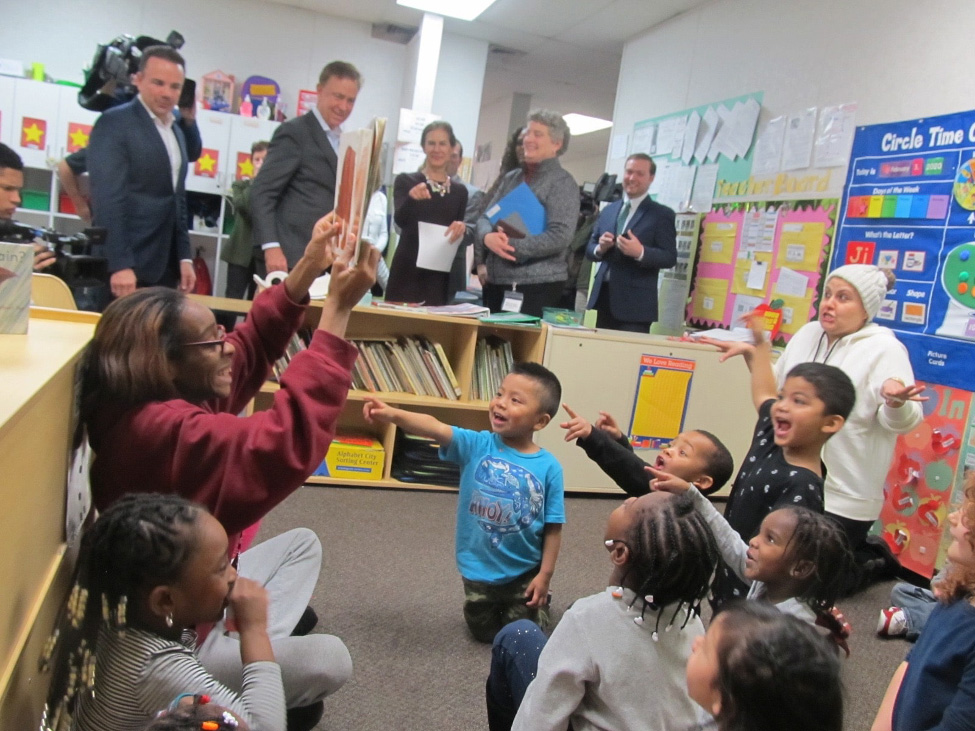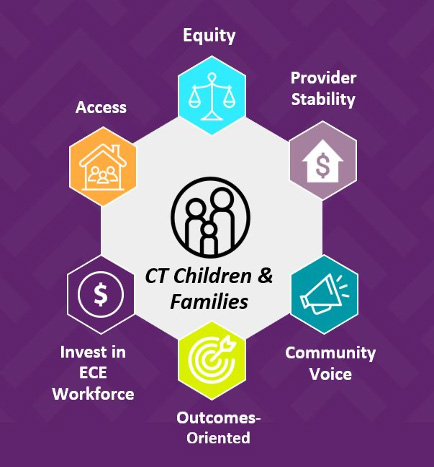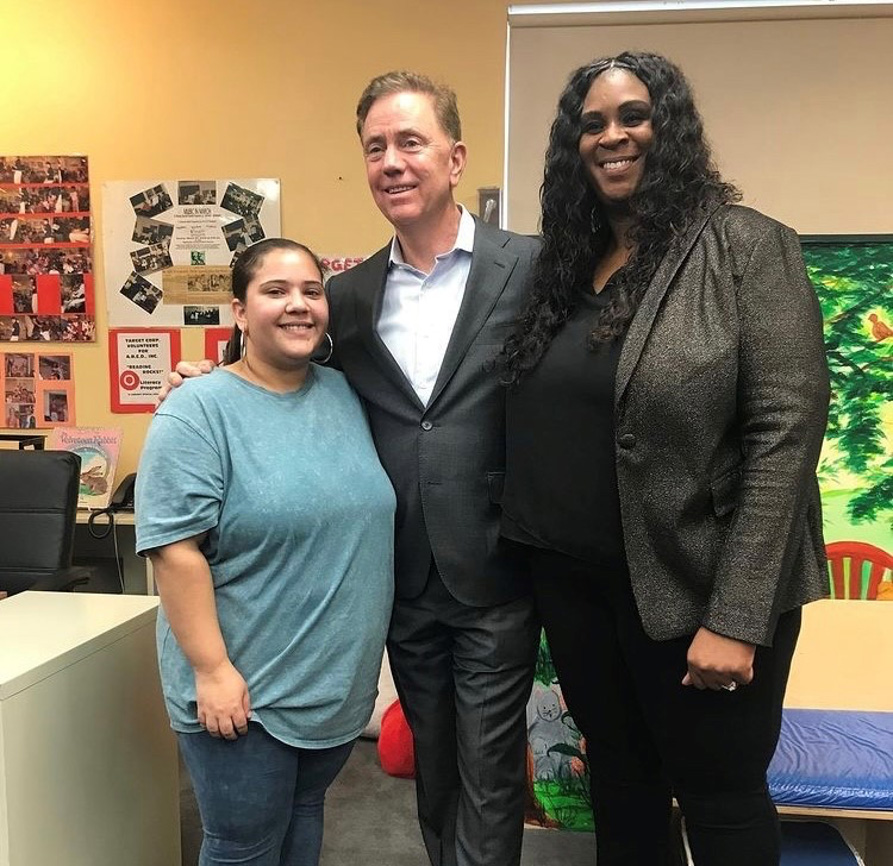Where do you go for the top news in Early Learning at the state level? Check out “5 Questions for the Governor,” where we’ll explore the top Early Learning challenges and successes in states across the nation. We’re thrilled to partner with The Hunt Institute on this series. Read them all.
1. Connecticut was awarded a $27 million Preschool Development Grant to design and launch better, more cost-effective systems to support family resilience and early childhood development. As states look to build stronger early childhood systems post-Covid, what lessons at the state learned that might contribute to this national conversation?
The pandemic revealed a lot of longstanding challenges and inequities within communities and in early childhood. Our Preschool Development Grant (PDG) has allowed us to implement a variety of improvements to our system throughout Covid in an effort to improve how children and families experience the first five years of life.
For example, the grant has helped Connecticut’s Office of Early Childhood to increase coordination and alignment across funding streams and sectors to make a bigger impact on the lives of our children and families.

Our initial PDG Birth-Five efforts helped build systems and infrastructure that have helped us respond to Covid-19. One of the things that’s very important to me is making sure we’re hearing the voices of those accessing services and affected by the pandemic. To that end, PDG funds are helping us to create a Parent Cabinet, which has helped inform both our response to Covid, and our systems reform work.
In addition to gathering feedback from parents, we were also able to leverage PDG resources to gather feedback from—and help communicate critical information to—the field, across agencies and sectors. Taken together, this feedback has helped to guide our investments and integrate our pandemic response efforts around two of my major priorities: technology innovation and workforce development.
In terms of technology, PDG resources have helped us connect families to early childhood development support through Sparkler, a parent-completed Ages and Stages Questionnaire (ASQ). Sparkler is a developmental screening tool in an app-based format that connects parents directly to CT’s Child Development Infoline. As indicated, families are referred to intervention services right through this app.
This has been especially important during the pandemic when so many children were not able to access the programs from which families usually receive referrals to disability and support services. More than 800 families completed the screening during the pandemic. The app also provides families with age-appropriate activities to support the healthy development of children. More than 300 families enrolled in our home visiting families participated in Sparkler as well.
We’ve also capitalized on PDG resources to lend capacity to our Governor’s Workforce Council, where we’re doing research to address family barriers to workforce development. Based on the lessons there, I dedicated $5 million in Covid relief funds to launch an innovative child care program for CT residents seeking employment and training. Workforce board clients were referred to free contracted child care slots as needed providing a clearer path to employment for families experiencing job displacement during the peak of the Covid-19 crisis.
Finally, I’d say that our PDG grant is very deliberately focused on equity. It’s critical to me that we ensure all children have access to opportunities that support their healthy growth and development. Part of that is as simple as making sure we’re communicating effectively. For example, we’ve worked across the PDG process to ensure our memos and communications to families and programs are translated into Spanish, allowing critical information to be shared in a timely and accessible manner.
The equity focus also extends to making sure that Covid relief funds are allocated to communities most in need of support. The state’s funding distribution formula has multiple variables grounded in equity, all designed to ensure the fiscal stability of child care providers in the state’s hardest hit communities.
The bottom line is that we have an unwavering commitment to creating and sustaining ecosystems where children are safe, healthy, learning and thriving. The PDG grant has been a great support here.
2. The state created an Office of Early Childhood in 2013 to coordinate and improve the various early childhood programs in the state to create a cohesive high-quality early childhood system. In what ways do you see this coordination contributing to the prosperity of Connecticut children and families?
The success and well-being of our state depends on our collective ability, across state and local agencies—and in partnership with community-based providers—to deliver coordinated, high-quality programs and services during the first five years of a child’s life. Having one agency overseeing early childhood programs is an advantage for children, families, programs and state oversight.
Through its core programs, our Office of Early Childhood supports infant and toddler care, preschool, after-school care, child care and youth camp licensing, credentialing, home visiting and early intervention to address developmental delays. Prior to 2015, these efforts were spread across five state agencies. Navigating a vast array of programs, eligibility criteria and requirements is already tough enough for families and providers. We believe one agency has led to better coordination and outcomes through the development of an agency-wide approach focused on the whole child and family.
This approach is advanced through our two-generation (2Gen) initiative. Children grow up in the context of families. 2Gen supports both children and parents to get the education, training and social supports needed to succeed, and allows parents to pass increased economic security onto their children.
As I mentioned, workforce development is one of my real areas of focus and the Office of Early Childhood has been leading the Equity and Access Committee of our Governor’s Workforce Council. Child care has emerged as a major hurdle for families seeking to advance themselves in the workforce. To address the child care needs of those pursuing employment and job training, the OEC has worked closely with the State Colleges and Universities to pilot child care access for the children of SNAP Employment and Training participants. By offering pathways to a living wage and removing barriers for families, children will prosper – especially when combined with high quality early childhood settings.

Simultaneously, Connecticut is in the midst of child care systems reform, to improve the quality of care and make it more accessible to families. Legislative and administrative changes are on tap this year. Fundamental reforms are needed to dramatically expand access to high quality care and ultimately produce better outcomes for all of Connecticut’s children and families. Our system reform vision is built around six interconnected elements (graphic at right).
3. Education Week’s recent “Chance of Success Index” ranked Connecticut third in the nation for providing opportunities for success throughout a student’s lifetime. In what ways do you see the state’s early childhood care and education system supporting this achievement?
There’s no question that Connecticut’s high rankings in many of these national child well-being assessments are a function of state investments and policies that demand high quality services. We’re very proud, of course, but can’t afford to be complacent. We still have work to do in assuring that all children have access to high quality services, and our administration is hyper-focused on making sure this will be the case for every Connecticut family.
We are pleased to rank in the top 10 states for children’s access to health care, which we know is the critical first step to supporting overall child development. Connecticut also invests significant state resources in early care and education with more than $195 million in state funding serving 17,000 3- and 4-year-old’s in state-funded spaces, supplemented by federal CCDF funds.
We’ve been really intentional about making sure this funding can start at age 3, understanding the value added by two full years of preschool for children. These funds are invested in high quality programs. Many states only appropriate federal funding, and do not require this high standard. Since 1997, our investments in early childhood have meant that CT is among the top 5 states in preschool access for children and families. (U.S. News & World Report, https://www.usnews.com/news/best-states/rankings/education/prek-12).
We know that early childhood programming lays the foundation for success in school and beyond. And we know that quality matters too. Twenty-five percent of our state’s early childhood programs are NAEYC Accredited, ranking us second in the U.S. My focus for the years ahead is on an improved early childhood system that is less economically fragile, more data-driven and informed by family, workforce/business, and provider input.
4. Connecticut’s former Commissioner of Education, Dr. Miguel Cardona, was recently named U.S. Secretary of Education. How does this reflect on CT’s own achievements?
We couldn’t be prouder of Dr. Cardona for his selection as Secretary of Education – the nation is getting a phenomenal leader for the Department of Education. Born to Puerto Rican parents and raised in a housing project, Dr. Cardona brings these real-life experiences to his work, and is a role model for students with similar backgrounds and experiences.
His passion for equity led him to serve as chair of CT’s Achievement Gap Taskforce to help narrow and close the achievement gaps. As a principal and Assistant Superintendent, Dr. Cardona brought preschool to Meriden schools. He describes ECE as the foundation for healthy learning and development.
While Commissioner of Education, Dr. Cardona was a champion of equity and opportunity for Connecticut’s children. His leadership was a game-changer during one of the most challenging chapters of the state’s history.
- He invested heavily in PPE and school resources so that teachers and students could safely return to school.
- He helped create nation-leading data systems to track student attendance and Covid-19 positivity rates so the state could understand the state of play across schools and redirect resources to the most struggling families.
- Finally, he helped craft the Everybody Learns Initiative—the state’s initiative to close the K-12 digital divide—providing 141,000 laptops and 41,000 internet connections to families across the state. Connecticut became the first state in the nation to provide a laptop and at-home internet connection to every student who indicated a need.

One other part of Dr. Cardona’s strength leading CT during the pandemic was his constant communication with educators. He was on the phone daily with superintendents and held weekly calls with Public Health that guided the State’s responsive approach to keeping schools open when possible. This is the kind of leadership Dr. Cardona will bring to the U.S. Department of Education, and the nation is lucky to have him.
5. You discussed education in your State of the State address, including points on recruiting black and Hispanic teachers, reducing the cost of education and expanding eligibility to Care 4 Kids. How do you see these investments as complementing your overall agenda for Connecticut?
We’re really working to improve the state’s efforts to recruit educators of color. We recently launched our Educators Rising program, a network that cultivates diverse, highly skilled educators by guiding young people of color into a pipeline to become teachers. As a state, we are reducing the cost of education by continued investment in making community college free to our neediest students across the state and seeking ways to expand eligibility to Care 4 Kids.
All of these efforts weave together as part of our administration’s commitment to providing a world class education and opportunity to every single student.
* All photographs were taken pre-pandemic.



